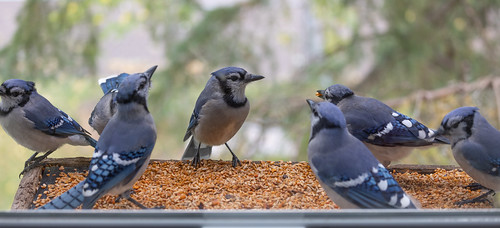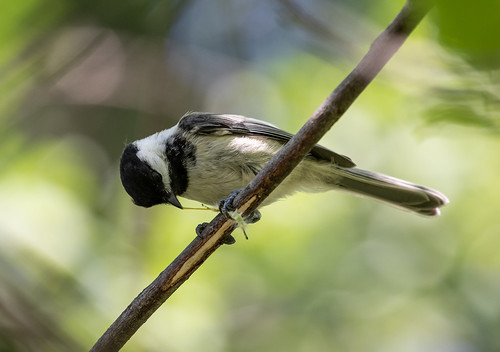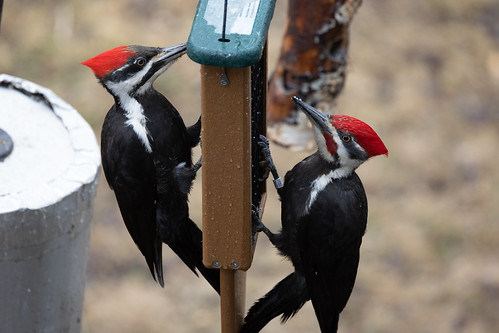This year I haven’t been able to set out that big feeder because of bears and rats in the neighborhood. I’ve even had to stop filling a small tray feeder in the backyard thanks to the rats, so the only feeder the jays can visit is the small tray feeder in my second-story home office window. The most jays I've seen in that one was 11, and the most I could capture in a photo today was 7.
Losing my big feeder reduces the number of jays I can see in any given moment but doesn’t seem to have affected how many are on this corner of Peabody Street, based on how many I'm hearing. Blue Jay numbers peak in mid-September, so it’s possible they won’t reach last year’s record high at Hawk Ridge, but as of 5 pm today the count is up to 58,810. Considering that 852 of them were counted today, there's a good chance they'll break last year's record in the coming days.
 |
| Sharp-shinned Hawk eyeing my Blue Jays in 2020 |
Here below Hawk Ridge, some of those jays are clearly in jeopardy. I’ve found clumps of Blue Jay feathers in my yard twice this week, and I freak out every time I hear the distinctive Blue Jay danger yell, but it’s the jays themselves dealing with this ever-present danger, not me, and they seem to shrug it off with equanimity except during actual or threatened attacks, and then for a little while afterwards. After yelling their heads off complaining, they go back to their usual jolly ways.
Blue Jays are exactly the right size to make a satisfying meal for a Merlin or Sharp-shinned Hawk, with enough calories to hold the predator for a full day. A Blue Jay weighs more than four times as much as a White-throated Sparrow, more than seven times more than a Yellow-rumped Warbler, and almost eight times more than a chickadee. I hate witnessing predation firsthand, especially on my favorite birds, but raptors have to eat, too. I’ve watched Blue Jays pull robin nestlings out of the nest, and even the sweetest chickadees rip apart innocent caterpillars—it’s a bird-eat-someone world out there.
Predation is hard on both ends of the talons. On Thursday, I looked out my window exactly at the moment a Merlin knocked a Ruffed Grouse out of the air. I’ve seen a Ruffed Grouse on my corner only once before in the 41 years I’ve lived here. This one, mortally injured, struggled on the ground, but the Merlin couldn’t pick it up—even the heaviest female Merlins weigh less than half what a grouse weighs, and bazillions of screaming jays and a murder of crows were clearly not going to let the Merlin eat it right there in the open, so it flew off, still hungry. The grouse died a few minutes later and I retrieved the carcass, too sad to take any photos. I gave it to Clinton Dexter-Nienhaus, who has a salvage permit and will have it prepared for display at the Sax-Zim Bog.
 |
| BB at my feeder October 1 |
Knowing that any day can be the last for any wild bird makes my encounters with special individuals even more precious. Last fall, a banded male Pileated Woodpecker who I nicknamed “BB” for Banded Boy started showing up. I photographed him whenever I could. I could usually capture just two or three numbers on the band, but little by little I managed to tease out the entire string of nine digits: #115423658.
BB came just about daily all fall and winter through late April. On April 23, I even got a photo of him and a female in my feeder at the same time—I'm pretty sure she was his mate and that they nested somewhere in the neighborhood, but not near my corner. Soon after that, he stopped coming entirely, and I didn’t see him, or indeed any Pileateds, in my yard through the summer.
 |
| A scruffy-looking BB on September 2 |
In September, I started seeing BB once or twice a week, at first looking very scruffy after apparently raising young. Now he’s coming daily again. He comes to the suet feeder but also to our very old box elders, the power poles behind the yard, and a stump I often sit on near our raspberry patch. This morning he showed up at the suet feeder and then a female—unbanded so I have no way of knowing if she’s his mate—came to my window feeder right as I started writing this very sentence. She stayed in the feeder for at least four minutes as I got photos and video of her with my old cell phone.
A couple of chickadees alighted on the feeder while she was in it, but the Blue Jays kept their distance until she’d flown off. A little while later, after I had my good camera, she or another female Pileated returned to that window feeder, and then a second female chased her off. A female appeared at that feeder at least 7 times through 4:30 pm, and BB made a second appearance in the suet feeder, as did at least one of the females.
My yard hasn’t had many rarities lately—the poor Ruffed Grouse is the only one I’ve noticed—but considering that chickadees, Blue Jays, and Pileated Woodpeckers are my top three favorite birds of all time, I’d say October is shaping up to be a splendid month.









